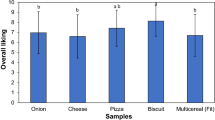Abstract
As the global market expands, it is critical that researchers understand how cultural factors influence the expectations and liking for a food product. The objectives of this study were to identify the optimal sweetness level for a sports-drink for consumers originating from different countries and to investigate the factors affecting the optimal sweetness level. In the first study, respondents (n=372) originated from 5 Asian countries and US tasted and evaluated the sports-drink at 4 sweetener levels. Consumers (n=256) from 3 Asian countries and US participated in the second study. Consumers evaluated the concept and sensory expectations for the ‘lemon-lime flavored’ sports-drink and other beverages. The optimal sweetness level for the sports-drink was lower for Americans than Asians. The familiarity to the product was a key factor affecting the optimal sweetener level. The results also suggested that information can differently influence the product acceptance depending on one’s familiarity with the product.
Similar content being viewed by others
References
Prescott J, Bell G, Gillmore R, Yoshida M, O’sullivan M, Korac S, Allen S, Yamazaki K. Cross-cultural comparison of Japanese and Australian responses to manipulations of sweetness in foods. Food Qual. Prefer. 8: 45–55 (1997)
Yeh LL. Use of hedonic scales among Chinese, Koreans, and Thais. MS thesis, Oregon State University, Corvallis, OR, USA (1999)
Moskowitz HW, Kumaraiah V, Sharma KN, Jacobs HL, Sharma SD. Cross-cultural differences in simple taste preferences. Science 19: 1217–1218 (1975)
Druz LL, Baldwin RE. Taste thresholds and hedonic responses of panels representing three nationalities. J. Food Sci. 47: 561–569 (1982)
Ishii R, Yamaguchi S, O’Mahony M. Measures of taste discriminability for sweet, salty, and umami stimuli: Japanese versus Americans. Chem. Senses 17: 365–380 (1992)
Laing D, Prescott J, Bell G, Gillmore R, James C, Best D, Allen S, Yoshida M, Yamazaki K. A cross-cultural study of taste discrimination with Australians and Japanese. Chem. Senses 18: 161–168 (1993)
Prescott J, Laing D, Bell G, Yoshida M, Gillmore R, Yamazaki K, Ishii R. Hedonic responses to taste solutions: A cross-cultural study of Japanese and Australians. Chem. Senses 17: 801–809 (1992)
Bertino M, Chan MM. Taste perception and diet in individuals with Chinese and European ethnic backgrounds. Chem. Senses 11: 229–241 (1986)
Chung L, Chung SJ. Cross-cultural comparisons among the sensory characteristics of fermented soybean using Korean and Japanese descriptive analysis panel. J. Food Sci. 72: S676–S688 (2007)
Cervellon M-C, Dubé L. Cultural influences in the origins of food likings and dislikes. Food Qual. Prefer. 16: 455–460 (2005)
Bertino M, Beauchamp GK, Jen KC. Rated taste perception in two cultural groups. Chem. Senses 8: 3–15 (1983)
Crandall CS. The liking of foods as a result of exposure: Eating doughnuts in Alaska. J. Soc. Psychol. 125: 187–194 (1985)
Laing D, Prescott J, Bell G, Gillmore R, James C, Best D, Allen S, Yoshida M, Yamazaki K, Ishii R. Responses of Japanese and Australian to sweetness in the context of different foods. J. Sens. Stud. 9: 131–155 (1994)
Birch LL, Marlin DW. I don’t like it; I never tried it: Effects of exposure on two-year-old children’s food preferences. Appetite 3: 353–360 (1982)
Zajonc RB. Attitudinal effects of mere exposure. J. Pers. Soc. Psychol. Monograph Supplement 9: 1–32 (1968)
Moskowitz HR, Kluter RA, Westerling J, Jacobs HL. Sugar sweetness and pleasantness: Evidence for different psychological laws. Science 18: 583–585 (1974)
Anderson RE. Consumer dissatisfaction: The effect of disconfirmed expectancy on perceived product performance. J. Marketing Res. 10: 38–44 (1973)
Olson JC, Dover PA. Disconfirmation of consumer expectations through product trial. J. Appl. Psychol. 64: 179–189 (1979)
Cardello AV, Maller O, Masor BM, Dubose C, Edelman B. Role of consumer expectancies in the acceptance of novel foods. J. Food Sci. 50: 1707–1718 (1985)
Deliza R, MacFie HJH. The generation of sensory expectation by external cues and its effect on sensory perception and hedonic ratings: A review. J. Sens. Stud. 11: 103–128 (1996)
Zellner DA, Brown JM. Effect of temperature and expectation on liking for beverages. Physiol. Behav. 44: 61–68 (1988)
Tuorila HM, Anderson A, Martikainen A, Salovaara H. Effect of product formula, information, and consumer characteristics on the acceptance of a new snack food. Food Qual. Prefer. 9: 313–320 (1998)
Peryam DR, Girardot N. Advanced taste-test method. Food Eng. 24: 58–61 (1952)
Prescott J. Comparisons of taste perceptions and preferences of Japanese and Australian consumers: Overview and implications for cross-cultural sensory research. Food Qual. Prefer. 9: 393–402 (1998)
Pliner P. The effects of mere exposure on liking for edible substances. Appetite 3: 283–290 (1982)
Author information
Authors and Affiliations
Corresponding author
Rights and permissions
About this article
Cite this article
Chung, SJ., McDaniel, M.R. & Lundahl, D.S. Sweetness preferences for a sports-drink among US and Asian consumers. Food Sci Biotechnol 19, 349–360 (2010). https://doi.org/10.1007/s10068-010-0050-x
Received:
Revised:
Accepted:
Published:
Issue Date:
DOI: https://doi.org/10.1007/s10068-010-0050-x




